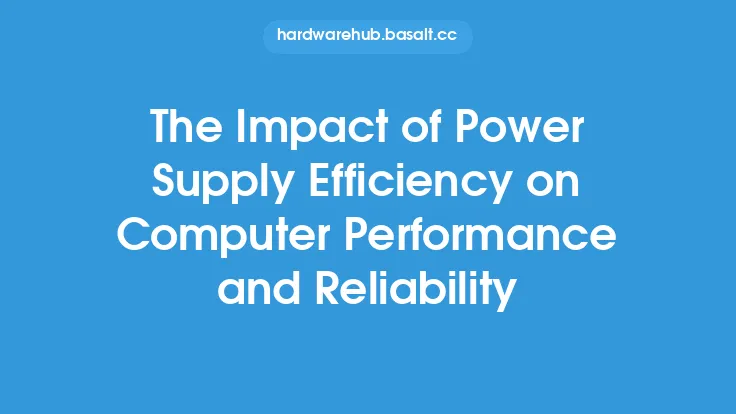When it comes to power supply efficiency, there are many misconceptions and myths that can make it difficult to separate fact from fiction. As a critical component of any computer system, the power supply plays a vital role in ensuring reliable and efficient operation. In this article, we will delve into the world of power supply efficiency, exploring the key concepts, technologies, and factors that affect it.
Introduction to Power Supply Efficiency
Power supply efficiency refers to the ability of a power supply unit (PSU) to convert the input voltage from the mains to the required output voltage, with minimal loss of energy. This is typically measured by the efficiency rating, which is expressed as a percentage. For example, an 80% efficient power supply means that for every 100 watts of input power, 80 watts are delivered to the system, while 20 watts are lost as heat. The efficiency rating is a critical factor in determining the overall performance and reliability of a power supply.
Factors Affecting Power Supply Efficiency
Several factors can affect the efficiency of a power supply, including the design and construction of the PSU, the quality of the components used, and the operating conditions. One of the primary factors is the type of switching technology used. Switching power supplies, which are the most common type, use high-frequency switching to regulate the output voltage. This can lead to energy losses due to switching losses, conduction losses, and other factors. Other factors that can affect efficiency include the input voltage, output current, and temperature.
Switching Technologies and Efficiency
There are several switching technologies used in power supplies, each with its own strengths and weaknesses. The most common types include pulse-width modulation (PWM), resonant switching, and quasi-resonant switching. PWM is the most widely used technology, but it can be less efficient than other methods, particularly at low loads. Resonant switching, on the other hand, can offer higher efficiency, but it can be more complex and expensive to implement. Quasi-resonant switching offers a balance between efficiency and cost, making it a popular choice for many power supplies.
Component Quality and Efficiency
The quality of the components used in a power supply can have a significant impact on its efficiency. High-quality components, such as capacitors, inductors, and MOSFETs, can help to minimize energy losses and improve overall efficiency. For example, high-quality capacitors can reduce the amount of energy lost due to capacitance leakage, while high-quality inductors can reduce the amount of energy lost due to core losses. Additionally, the use of high-quality MOSFETs can help to reduce switching losses and improve overall efficiency.
Efficiency Standards and Ratings
There are several efficiency standards and ratings that are used to measure the efficiency of power supplies. The most common standards include the 80 PLUS rating, which is a widely recognized standard for power supply efficiency. The 80 PLUS rating is based on the efficiency of the power supply at 20%, 50%, and 100% loads, and it provides a clear indication of the power supply's efficiency. Other standards, such as the Energy Star rating, can also provide guidance on the efficiency of power supplies.
Measuring Power Supply Efficiency
Measuring power supply efficiency can be a complex task, requiring specialized equipment and expertise. The most common method is to use a power analyzer, which can measure the input and output power of the power supply. The efficiency can then be calculated by dividing the output power by the input power and multiplying by 100. Additionally, other factors, such as the power factor and total harmonic distortion (THD), can also be measured to provide a more complete picture of the power supply's performance.
Conclusion
In conclusion, power supply efficiency is a critical factor in determining the overall performance and reliability of a computer system. By understanding the key concepts, technologies, and factors that affect efficiency, users can make informed decisions when selecting a power supply. Whether you are building a new system or upgrading an existing one, choosing a high-efficiency power supply can help to reduce energy consumption, minimize heat generation, and improve overall system reliability. By separating fact from fiction and understanding the evergreen information aspect of power supply efficiency, users can make the best choice for their needs and ensure optimal system performance.





